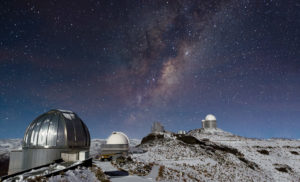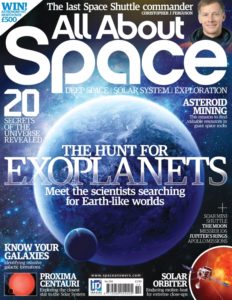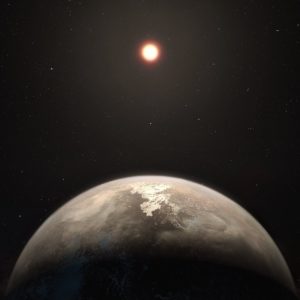Nov
19
About That Newest Exoplanet…
“If scientists are able to detect gases like oxygen in the atmosphere of Ross 128 b, that could be a good indicator of biological processes on the planet.” — Molly Rubin (Quartz Media)
It seems like a new exoplanet (aka “extrasolar planet”, i.e., a planet in a solar system other than ours) is found every couple of weeks these days. And that’s awesome! The latest has been dubbed Ross 128 b, and it is currently 11 light years away from Earth, though slowly getting closer. It was discovered by the European Southern Observatory (ESO) team, using their High Accuracy Radial-velocity Planet Searcher (HARPS) instrument at La Silla Observatory in Chile, though no other instruments have detected it, yet. The paper describing the team’s discovery has now been published in the journal Astronomy and Astrophysics.

Milky Way shines over La Silla Observatory
(Photo by José Francisco Salgado, an ESO Photo Ambassador.)
The exoplanet’s star, Ross 128, is a red dwarf or M-class star. This is the most common type of star in the universe, and the fact that they are smaller and dimmer than other types makes it easier to find planets in their vicinity. HARPS detects exoplanets via spectrographic analysis, using high-contrast imaging and high-dispersion spectroscopy. (Specifically, this is hooked up to the 3.6 meter telescope on the right in this image.) In other words, it identifies a regular shift in a star’s light, indicative of “a tiny wobble in the star’s position toward and away from us, due to the gravitational tug of an orbiting planet.”
Unlike its neighbor Proxima Centauri, Ross 128 is rather “quiet”, in that it does not produce flares, which normally douse any nearby planets in deadly radiation. Our own Sun — a G-type main-sequence star or “yellow dwarf” — is relatively well-behaved, its solar flares/storms having so far only temporarily disrupted GPS satellites and other electronic equipment. Solar radiation emitted from Ross 128 is thought to be roughly comparable to that from our Sun.
Now, from some of the headlines and statements in the popular press, you might think that this “potentially habitable”, “newfound Earth-like” world was almost certainly an “Earth twin”. Truth is, though, the scientists involved aren’t saying anything close to these claims, ‘cuz they can’t. The data doesn’t (yet) support it. But, such hype about these types of subjects — i.e., Earth-like planets and the search for life (or a possible explanation for the origins of life) — is common, because they are hot topics among many scientists and laymen alike. It seems like science writers, and occasionally even the researchers being interviewed, can’t help but throw out slight exaggerations and speculations, while sometimes leaving out other information that might put a damper on some of the excitement.
Why do they do this? For one, sensationalistic headlines generally attract readers/subscribers, which means more money for the publication. For another, keeping the general public excited about (potential) discoveries and advances in scientific knowledge helps gain support for funding for more research. In other words, follow the money. I can understand and accept a certain degree of this, but the more they stretch the truth, the more they undermine the journalistic integrity of their publication and the industry in general. It results in a misinformed public. And, it allows for some funding to be misdirected to undeserving projects. (Just speaking in general, here.)
 As much as I enjoy seeing scientific discoveries and advances and love speculating about the future, I think too many people have very unrealistic expectations about space travel, the likelihood of (sentient?) extraterrestrial life, etc. For example, people are now becoming familiar with references to a planet’s “habitable zone” — i.e., “the range of orbits around a star within which a planetary surface can support liquid water given sufficient atmospheric pressure.” So, in this case, the mantra is “Follow the water!” But, there is a huge number of other fine-tuning factors that need to be just right for life to be possible. (See, for example, my series “Living on a Razor’s Edge”. Here’s Part 3.) Dr. Hugh Ross has even identified nine different types of overlapping habitable zones that the Earth sits in which allow it to support advanced life or possibly life at all:
As much as I enjoy seeing scientific discoveries and advances and love speculating about the future, I think too many people have very unrealistic expectations about space travel, the likelihood of (sentient?) extraterrestrial life, etc. For example, people are now becoming familiar with references to a planet’s “habitable zone” — i.e., “the range of orbits around a star within which a planetary surface can support liquid water given sufficient atmospheric pressure.” So, in this case, the mantra is “Follow the water!” But, there is a huge number of other fine-tuning factors that need to be just right for life to be possible. (See, for example, my series “Living on a Razor’s Edge”. Here’s Part 3.) Dr. Hugh Ross has even identified nine different types of overlapping habitable zones that the Earth sits in which allow it to support advanced life or possibly life at all:
1. Liquid Water
2. Ultraviolet
3. Photosynthetic
4. Ozone
5. Rotation-Rate
6. Obliquity
7. Tidal
8. Astrosphere
9. Electric Wind
Back to our current exoplanet discovery…
What can so far be deduced (or, at least, inferred from statistical data) about Ross 128 b ?:
o rocky(?) planet with mass at least 1.3x (maybe 1.35x) that of Earth
o orbits its star in ~9.9 days at 1/20 the distance that Earth is from our Sun
o rotates slowly and has weak magnetic activity, which increases likelihood of atmospheric retention
A few crucial things we do not yet know:
o any atmospheric oxygen?
o surface temperature? (needs to be between -60°C (-76°F) and +20°C (+68°F) to be considered temperate)
o any liquid water? (“the distance from its star potentially puts it in the “habitable zone””)
o mineral composition
I was pleasantly surprised that the article from Slate was fairly honest about what has and hasn’t been determined about Ross 128 b:
“As with every other exoplanet we like to call “potentially habitable,” there’s no indication whether the planet has water on its surface. There isn’t even any sign as to whether the planet possesses other elements essential to life as we know it, like atmospheric oxygen. So unfortunately, it would be a stretch to label Ross 128 b as “potentially habitable.””
Good for them!
In fact, if you read just the paper‘s Abstract, you will find habitability mentioned once but no grand claims or promises of life. They list various readings and a few inferences made, but they admit that there is a lot that they don’t know and must wait for much more data and advances in instrumentation. As the Slate article summarizes,
“Some of these questions could be resolved relatively soon. The ESO’s Extremely Large Telescope (ELT) could find out whether Ross 128 b possesses oxygen or other chemical markers that could be signs of habitability or extant life. But others, such as the presence of water, are going to require more advanced instruments that we have yet to develop. Maybe we’ll have them by the time the planet gets closer.”
Notice that they say “could be resolved relatively soon”, “could find out”, and “could be signs…”. This sounds more hopeful than factual, since the CBSNews article I read indicates that the current instruments probably can’t do it.
“The astronomers studying Ross 128 b hope the next generation of telescopes set to come online in a few years can determine what kind of atmosphere Ross 128 b has and check for signs of life, including the presence of oxygen.” (italics added)
Bottom line here is that this is all very exciting, even without the hype and wishful thinking. As a general rule, when reading articles about such discoveries, take notice of words and phrases like “could reveal”, “may discover”, “might be”, “potentially”, “seems to be”, etc. They may sound like “weasel words”, but they probably indicate that the scientists in question are more cautionary in their rhetoric than the hypesters. Also, if you can find it, you might want to check out the Abstract for any paper connected to the discovery being reported. You will likely find that the link between the popular headlines and what the researchers actually say is often rather tenuous.
















